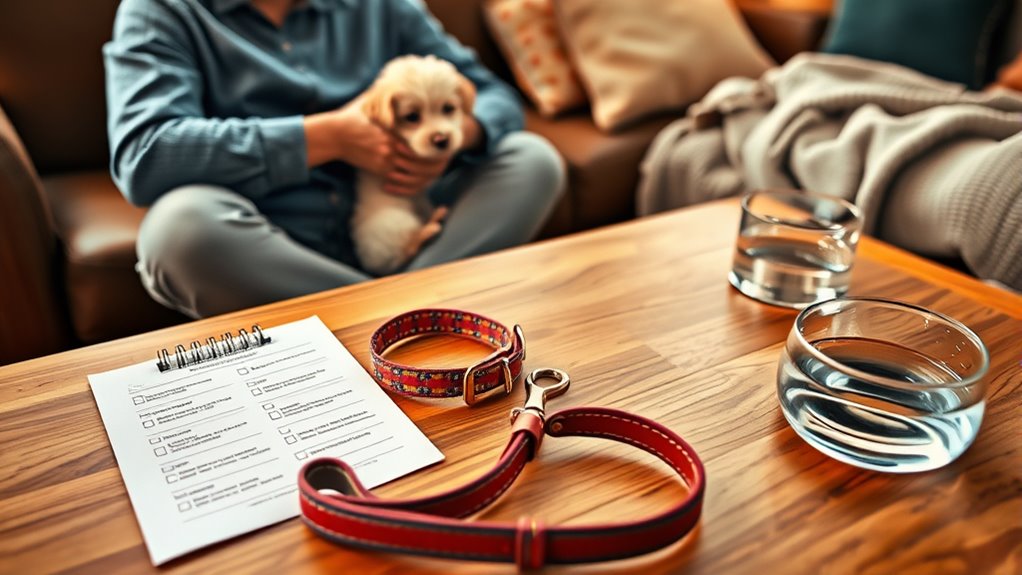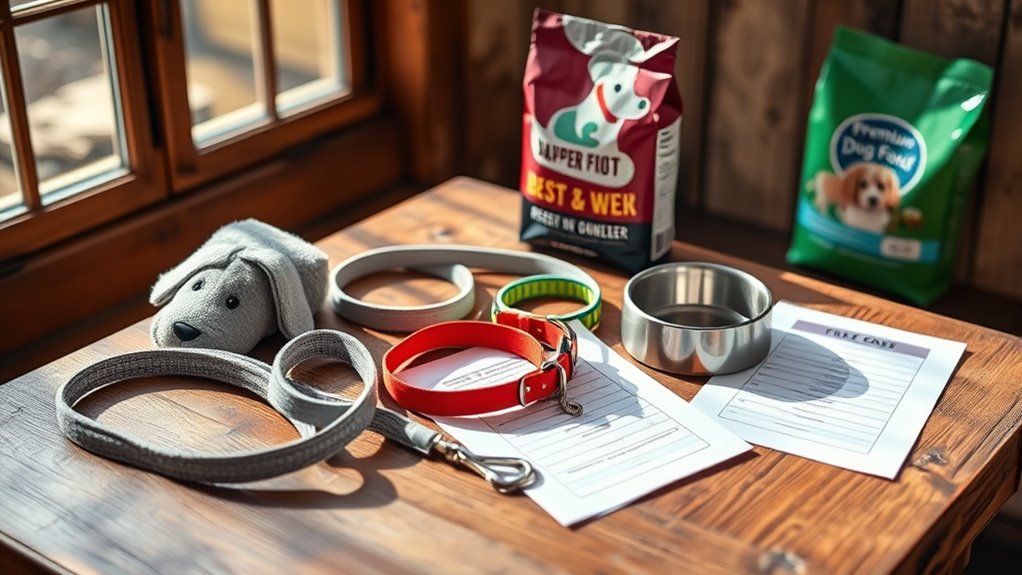As a first-time dog owner, start with establishing a consistent training routine using positive reinforcement and basic commands like sit, stay, and come. Set up a designated feeding area and stick to measured portions that suit your dog’s age and activity level. Keep training short and rewarding, involve your household, and stay patient. Ongoing care and a growth mindset are key—if you keep these tips in mind, you’ll build a strong bond and set your new pup up for success.
Key Takeaways
- Establish a consistent training routine focusing on basic commands with positive reinforcement.
- Prepare a designated, quiet feeding area and follow appropriate feeding guidelines.
- Use high-quality dog food, measure portions carefully, and ensure fresh water is always available.
- Involve all household members in training and feeding routines for clarity and consistency.
- Recognize that training and care are ongoing; stay patient, adaptable, and informed about professional techniques.
Essential Tips for First-Time Dog Owners

Getting a dog for the first time can be exciting, but it also comes with important responsibilities that you need to prepare for. One of the first steps is establishing a solid foundation through training tips and feeding guidelines. Proper training helps your new pet become well-behaved and confident, while feeding guidelines ensure they stay healthy and energized. Starting with consistent training from day one makes a big difference, so focus on basic commands like sit, stay, and come. Keep training sessions short and positive, rewarding your dog with treats or praise to reinforce good behavior. Remember, patience is key; puppies and new dogs learn at different speeds, so stay calm and persistent. Incorporate routines into your daily schedule to help your dog understand what to expect, which reduces anxiety and promotes good habits. When it comes to feeding, follow specific feeding guidelines based on your dog’s age, size, and activity level. This means measuring portions carefully and sticking to a regular feeding schedule. Avoid overfeeding or free feeding, as it can lead to obesity and health issues. Use high-quality dog food recommended by your veterinarian, and gradually introduce new foods to prevent stomach upset. Fresh water should always be available, and you should monitor your dog’s weight and energy levels to adjust portions if necessary. Proper nutrition supports your dog’s growth, immune system, and overall well-being. Additionally, establish a designated eating area that’s quiet and free from distractions, encouraging your dog to eat calmly and consistently. As you go through these initial steps, remember that training and feeding are ongoing processes. Consistency and patience will help your dog learn good manners and develop healthy eating habits. Incorporating training consistency and positive reinforcement techniques can significantly improve your dog’s learning process. Furthermore, involving your entire household in feeding routines ensures clear communication and helps your dog understand expectations, reducing confusion and anxiety. Regular training tips include rewarding good behavior immediately, avoiding punishment, and reinforcing commands with repetition. For feeding, stick to the guidelines provided by your vet or the pet food manufacturer, and avoid giving your dog human food or treats outside of recommended amounts. This consistency helps prevent behavioral issues and health problems down the line. Developing a growth mindset can also help you stay motivated and adaptable as you navigate the challenges of new pet ownership. Being aware of training techniques used in professional settings can also provide valuable insights to enhance your approach.
Frequently Asked Questions
How Do I Choose the Right Dog Breed for My Lifestyle?
When choosing the right dog breed, focus on your lifestyle compatibility. Think about your activity level, living space, and daily routine. If you’re active and outdoor-oriented, breeds like retrievers or border collies might suit you. If you prefer a calmer environment, consider smaller or less energetic breeds. Research different breeds for their temperament and needs, ensuring your dog’s traits match your lifestyle for a happy, harmonious relationship.
What Are the Signs of Common Health Issues in Puppies?
You should watch for signs like lethargy, loss of appetite, vomiting, or diarrhea, which could indicate health issues in puppies. Keep up with puppy vaccination schedules to prevent illnesses, and make certain flea prevention is in place to avoid infestations. If your puppy shows persistent symptoms or unusual behavior, consult your vet promptly. Early detection and preventive care help keep your puppy healthy and happy.
How Can I Effectively Socialize My New Dog?
To effectively socialize your new dog, start early with puppy playdates and expose them to different people, animals, and environments. Use positive reinforcement to encourage good behavior and build their social skills. Keep sessions short and fun to prevent overwhelm. Consistently introduce new experiences gradually, and always supervise interactions. This approach helps your dog become confident, well-adjusted, and comfortable in various situations.
What Should I Do if My Dog Shows Signs of Separation Anxiety?
Did you know that nearly 17% of dogs suffer from separation anxiety? If your dog shows signs, you can help by using desensitization techniques, gradually increasing time apart so they learn to feel secure. Calming aids, like pheromone diffusers or calming treats, can also ease their stress. Stay patient and consistent, and over time, your dog will feel more comfortable being alone.
How Do I Establish a Consistent Training Routine?
To establish a consistent training routine, you should set clear training schedules that fit your daily life, ensuring your dog knows when to expect training sessions. Use reward systems like treats or praise to reinforce positive behaviors consistently. Keep sessions short and frequent, and stay patient. This consistency helps your dog understand expectations, builds trust, and accelerates learning, making training more effective and enjoyable for both of you.
Conclusion
Becoming a first-time dog owner is like planting a seed—you’ll nurture, learn, and grow together. Remember to be patient, stay consistent, and shower your pup with love. Every walk, cuddle, and training session builds your bond stronger. Trust yourself; you’re capable of this adventure. With care and commitment, you’ll enjoy a friendship as warm and steadfast as the sun rising each day. Your journey with your dog is just beginning, and it’s bound to be amazing.










